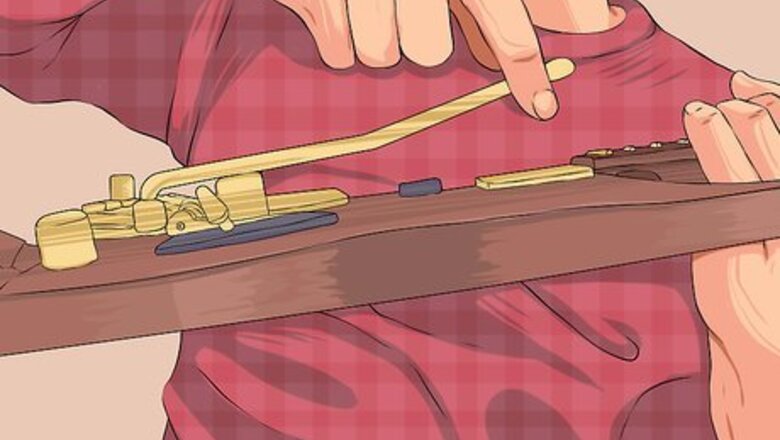
views
Setting Up Your Whammy Bar
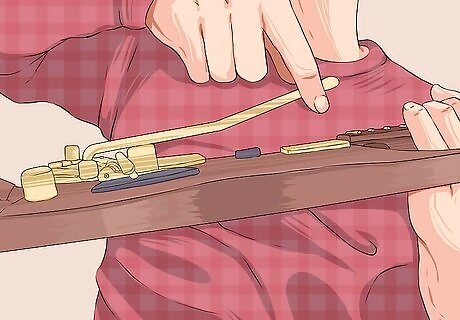
Examine your guitar. Some guitars do not have the capability to mount a whammy bar. Take a look at the bridge of your guitar. The bridge is near the bottom of the body and is where the strings’ ends are held. You should see a small hole, if your guitar is able to hold a whammy bar. Some guitars come with a permanent whammy bar that cannot be removed.

Take it to the shop. If you have a Fender Telecaster or Stratocaster, you’ll be better off letting the music store fit the whammy bar. Many whammy bars look the same, but come in different sizes and fits. Les Paul guitars require you install a tailpiece onto the bridge and body to hold the whammy bar. The two main types of whammy bars are the detachable ones (Floyd Rose and Fender style) and whammy bars that require a tailpiece (Bigsby). All guitars are different and the method for installing a tailpiece could be different. For example, a Les Paul might look the same as a Gretsch model, but installing a whammy bar is different for the two.
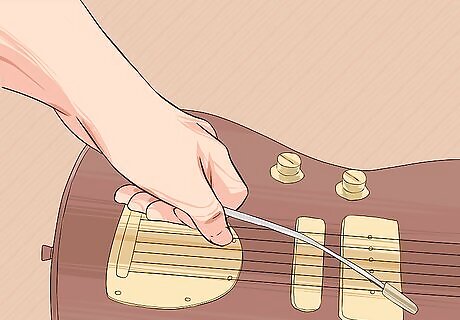
Test the connection. Make sure you have your whammy bar set up correctly. A whammy bar that is not set up correctly can lead to issues with your bridge. Some whammy bars don’t require to be screwed on to the bridge. For these bars, you simply insert them into the slot and you're ready to rock. If you have a whammy bar that screws in, make it tight, but not too tight. Some guitarists like their whammy bars looser than others. For tailpiece whammy bars, you’ll need to make sure your bridge and tailpiece are firm. Be careful not to misplace any screws from your bridge, if you install it on your own. Talk to someone at the music shop before you install a tailpiece. Be sure you purchase the right type of system for your guitar. Music shops won't charge too much for a job like this, and you're guaranteed quality work.
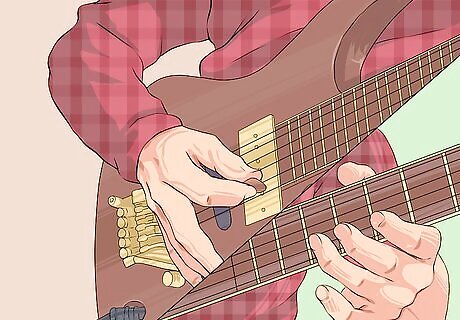
Listen for the whammy. Study how the whammy bar works by listening to a range of music. This will help you understand what you can do yourself with the whammy bar. You can use whammy in the minimal surf guitar style or the shredding chaos of heavy metal. There are other types of music that use whammy bars for sound textures and tonal depth like Sonic Youth and My Bloody Valentine. Dan Erlewine Dan Erlewine, Guitar Repair Expert When installing a new whammy bar, lubricate the pivot points with light oil and tighten the bar just enough so it stays in place when you release it. Slowly increase tension while checking tuning until the bar returns smoothly without losing pitch.
Using the Whammy Bar
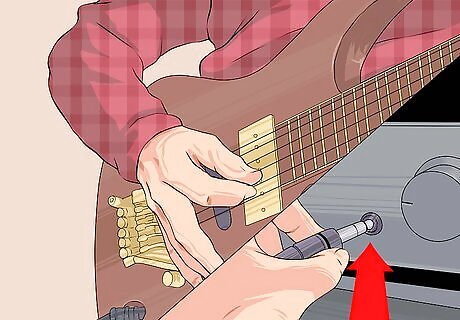
Get comfortable with the bar. Plug your guitar into an amps and try playing a note. Gently push the whammy bar down. This will drop the pitch of the sound. Practice playing chords and riffs and add the whammy bar. Depending on what type of guitar you have, your tuning will be affected by heavy use of the whammy bar. Cheaper guitars will go out of tune much faster than higher quality guitars. Floyd Rose usually comes with tuning locks for the guitar strings. The locks are designed to keep the strings in tune after heavy use of the whammy bar.
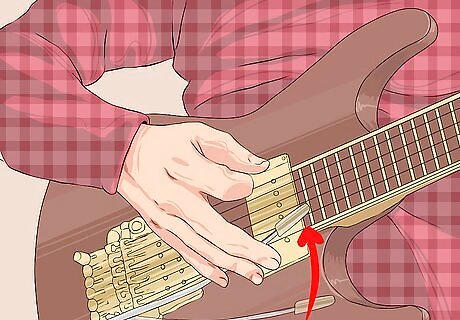
Pull up on the whammy. Now try to lift up on the whammy bar, but don't pull too high. Originally, whammy bars were only made to dip the notes. Pulling up on the bar stretches the strings. This raises the pitch instead of lowering the pitch. You might not be able to do this with tailpiece whammy bars.
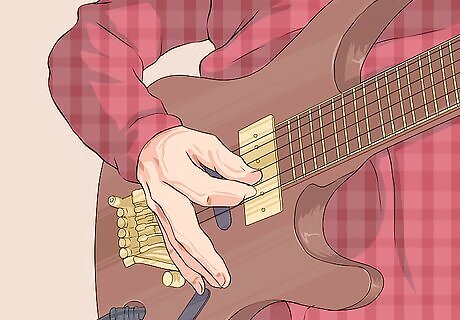
Do the dive. The dive is a classic technique for the whammy bar. Stroke a note or chord on the guitar and press firmly on the bar towards the strings. Famous heavy metal solos begin and end with the dive. As the name suggests, the dive is when the sound of your guitar quickly ‘’dives’’ into a deeper register. Experiment with using this technique. Try it out during soloing or as an ending to a riff. Listen to solos by Jimi Hendrix, Eddie Van Halen, and Dimebag Darrell for inspiration.
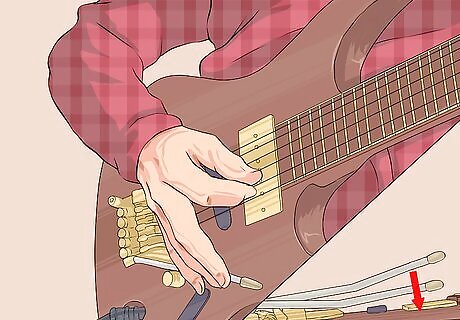
Perform the flutter. The flutter is when you waver the notes of your guitar in a short burst. Practice the flutter by tapping down on the bar and releasing the bar suddenly. Some players prefer to position the whammy bar towards the bottom of the guitar. The flutter is best used on a Floyd Rose whammy bar. The flutter is a great effect when used sparingly. Try tapping your whammy bar while playing chords or performing a riff.
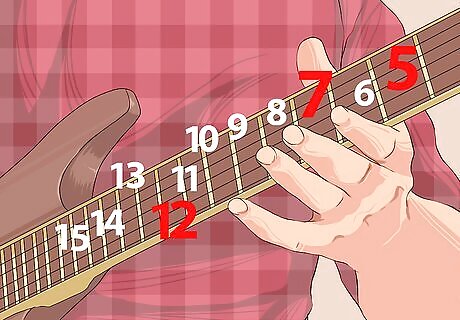
Practice the shriek. The shriek is when you create a shrieking sound out of your guitar by using the whammy bar. You need to play an open harmonic or pinch harmonic. Play an open harmonic by gently touching a string on the fifth, seventh, or twelfth fret. Once you hit the harmonic, pull up on the whammy bar to create a higher pitched shriek. Never press down fully when playing open harmonics. It is best to position your finger directly over the fret. A pinch harmonic is when you pick a note and graze the string with your thumb. This technique will take some time to develop. It is easier to do on the middle two strings (D and G). The pitch harmonic creates a higher sounding shriek.
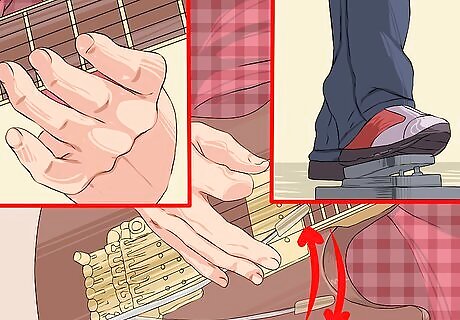
Use the shoegaze grip. Shoegazing is a genre developed in the late 80s and early 90s. The name is derived from guitarist who are constantly modifying their tone through pedals and guitar work. From the audience's perspective, they’re looking (or gazing) at their shoes. Hold the whammy bar in your hand and move it to the beat of the song. The idea is to play chords, but use the whammy bar heavily throughout the chord progression. Practice synchronizing your strum with the movement of the whammy bar. This technique isn’t the best for your strings, but the sound is unparalleled.
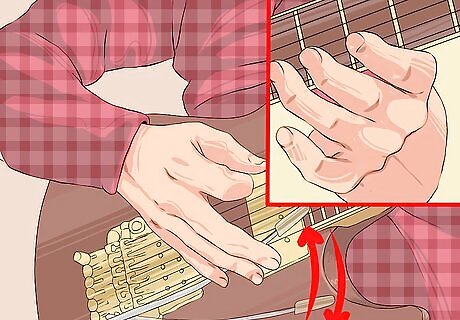
Play surf guitar. Surf guitar is all about using the whammy bar sparsely, unlike shoegaze. Surf guitar is usually centered around a riff or two that is played using tremolo picking (or alternate picking). Tremolo picking is when you play a riff by alternating upward and downward picking at a rapid pace. The whammy bar is best used in surf guitar at the end of a verse or melody. Listen to classic 50s surf music to hear this technique in practice. Try listening to Dick Dale and Link Wray.
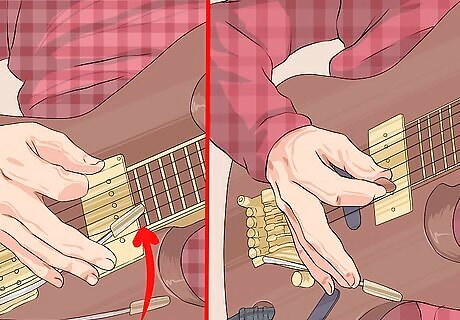
Practice the guitar. The best way to improve your whammy bar skills is through practice. Don’t neglect scales and chord shapes because you can use a whammy bar. The best guitarists know their scales and when to properly use the whammy bar. Keep an ear open for the use of whammy bars in music as you begin to develop your own style. EXPERT TIP Nicolas Adams Nicolas Adams Professional Guitarist Nicolas Adams is a 5th generation musician of Serbian Gypsy descent and the lead guitarist of the band Gypsy Tribe. Based in the San Francisco Bay Area, Nicolas specializes in Rumba Flamenco and Gypsy jazz and playing the guitar, Bouzouki, Balalaika, and piano. Nicolas Adams Nicolas Adams Professional Guitarist Try using the strings to get a similar sound if you don't have a whammy bar. You can get the same effect by bending the strings up or down to change the note. However, it's easier to use a whammy bar on strings with a heavier gauge.
















Comments
0 comment